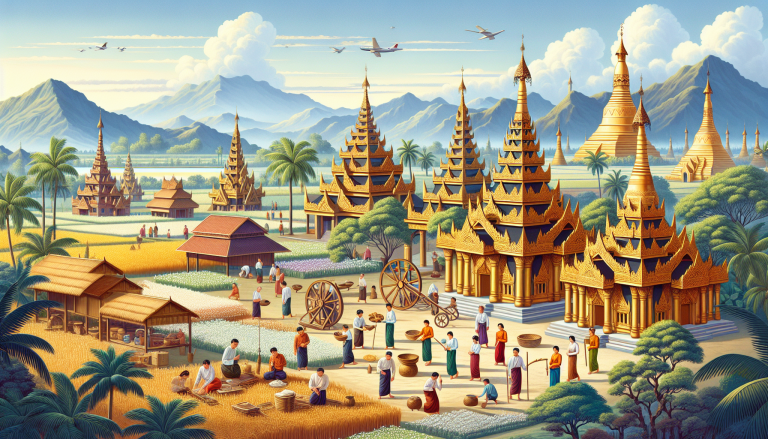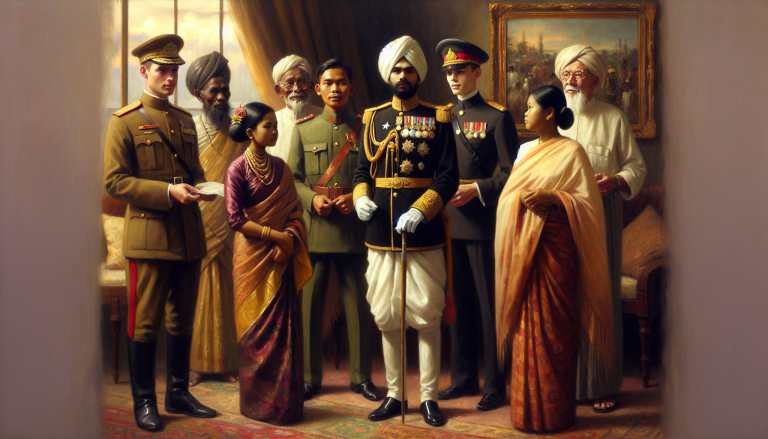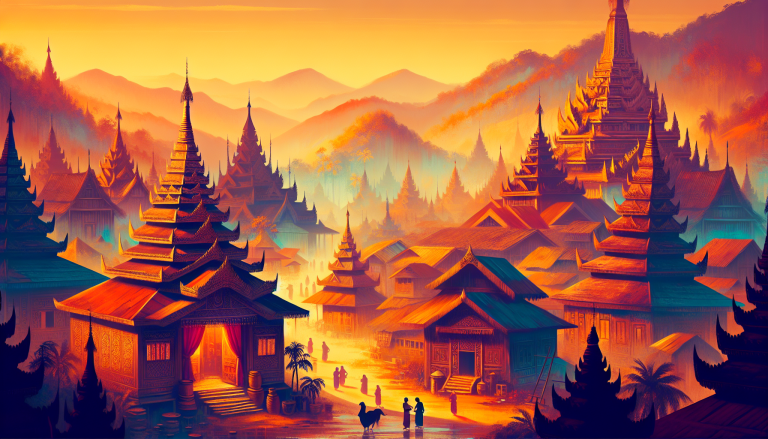Adventure Awaits: Explore the Rich Tapestry of Myanmar History Facts
Dive into Myanmar history facts! Unearth ancient civilizations and modern twists in this rich, cultural tapestry.

Ancient Burmese Civilizations
Exploring Myanmar’s rich tapestry of history takes you back to the time of ancient civilizations. Two prominent early civilizations that shaped the region were the Pyu city-states and the Mon kingdoms.
Pyu City-States
The Pyu city-states were the earliest recorded civilizations in Myanmar, thriving between the 2nd century BCE and the 9th century CE. These city-states were located in the Irrawaddy River valley in Upper Myanmar. The Pyu people were Tibeto-Burman speakers and established a network of city-states that were crucial in the early development of Burmese culture.
The Pyu city-states, such as Sri Ksetra, Beikthano, and Halin, were known for their advanced urban planning, brick fortifications, and extensive use of silver and gold in ornaments. These city-states were also key conduits for the introduction and spread of Buddhism in the region. For more details on the ancient artifacts and sites, visit our page on Pyu civilization Myanmar.
Mon Kingdoms
In Lower Myanmar, the Mon kingdoms emerged as significant cultural and political entities. The Mon people are believed to have settled in the region as early as 3000 BCE. By the 9th century, they had established prominent kingdoms such as Thaton and Pegu. The Mon were instrumental in the spread of Theravada Buddhism throughout Southeast Asia, cementing it as a dominant religious and cultural force.
The Mon kingdoms were known for their contributions to art, architecture, and literature. They played a pivotal role in shaping Myanmar’s cultural landscape through the construction of elaborate temples and monasteries adorned with intricate carvings and sculptures. You can learn more about their architectural achievements at Myanmar ancient architecture.
| Civilization | Period | Location | Key Characteristics | Influence |
|---|---|---|---|---|
| Pyu City-States | 2nd century BCE – 9th century CE | Upper Myanmar | Urban planning, fortifications, Buddhism | Early Burmese culture |
| Mon Kingdoms | 9th century – 16th century | Lower Myanmar | Temples, Theravada Buddhism, literature | Spread of Buddhism |
Both the Pyu and Mon civilizations laid the foundation for Myanmar’s rich cultural and historical heritage. By traveling through ancient sites and learning about these early kingdoms, you can gain a deeper appreciation for the myanmar history and culture that has evolved over the centuries. For more in-depth information, don’t forget to check out the ancient Myanmar civilizations section.
Rise of the Pagan Kingdom
The rise of the Pagan Kingdom marks a significant chapter in Myanmar history. This period saw the migration of the Bamar people and the establishment of Theravada Buddhism as a dominant force.
Bamar People Migration
In the 9th century, the Bamar people, speakers of the Tibeto-Burman language, migrated to the upper Irrawaddy valley. Their arrival marked the foundation of the Pagan Kingdom in the 1050s, which played a crucial role in shaping the cultural and political landscape of Myanmar.
The influx of the Bamar people led to the development and dominance of the Burmese language and culture. The Pagan Kingdom quickly became a significant power in the region. The establishment of the kingdom also laid the groundwork for future political structures and helped define the kingdom’s boundaries.
| Timeline | Key Event |
|---|---|
| 9th Century | Bamar people migrate to upper Irrawaddy valley |
| 1050s | Establishment of the Pagan Kingdom |
For more on the history and achievements of ancient Myanmar civilizations, visit our section on ancient Myanmar civilizations.
Dominance of Theravada Buddhism
The Pagan Kingdom is also noted for its significant role in promoting Theravada Buddhism. The kingdom adopted Theravada Buddhism as the state religion, which marked a shift from the previously dominant forms of Buddhism and local animist practices (Wikipedia).
This religious transformation had a profound impact on Burmese society. Monks and scholars from the Mon Kingdoms and Ceylon were invited to teach and help propagate Theravada texts, blending these teachings with local beliefs (ISICAL).
The architectural achievements of the Pagan Kingdom speak volumes about the influence of Theravada Buddhism. The kingdom is home to thousands of temples and monasteries, which are some of the most conspicuous manifestations of Buddhist culture in Myanmar. The intricate designs and sculptures found on these structures reflect the blend of Buddhist and Burmese artistic traditions.
| Element | Influence |
|---|---|
| Religion | Theravada Buddhism as state religion |
| Architecture | Temples and monasteries with intricate designs |
| Culture | Blend of Buddhist practices and Burmese traditions |
Learn more about the impact of Theravada Buddhism on Burmese culture in our section on Theravada Buddhism in Myanmar.
The rise of the Pagan Kingdom not only shaped the cultural framework but also marked the beginnings of a unified political entity in Myanmar. Dive deeper into the rich tapestry of Myanmar history and discover more about its ancient dynasties in our article on the Pagan Empire Myanmar.
Colonial Era to Independence
The colonial era in Myanmar’s history marked significant changes and set the stage for its eventual independence.
British Rule to Independence
Myanmar, then known as Burma, came under British control in the 19th century. The British expanded their reach over Myanmar through a series of Anglo-Burmese wars. By 1886, the entire country was under British colonial rule. This period saw the introduction of Western education, infrastructure development, and the integration of Burma into the global economy, but it also entailed exploitation and resistance.
Burma’s struggle for independence gained momentum in the early 20th century, with nationalists like General Aung San playing a pivotal role. The country finally achieved independence from British rule on January 4, 1948 (Associated Press). This was a significant milestone in burmese history timeline, marking the end of colonial dominance and the beginning of a new era for Myanmar.
Military Coup of 1962
After gaining independence, Burma started as a parliamentary democracy. However, this period of representative democracy was short-lived. On March 2, 1962, General Ne Win led a successful military coup, overthrowing the democratic government (Council on Foreign Relations). This coup ushered in a long era of military rule, significantly shaping modern Myanmar history.
General Ne Win established a military junta that ruled the country with an iron fist for 26 years. The junta implemented socialist economic policies, which isolated the nation and led to widespread poverty and economic stagnation. The suppression of political dissent and ethnic minorities further exacerbated the problems.
The aftershocks of the 1962 coup are still felt today, influencing the political landscape and contributing to subsequent military interventions, such as the shocking military coup of 2021.
By understanding these key historical events, travelers can gain a richer perspective on myanmar history and culture and appreciate the resilience and complexity of its people. Be sure to explore related topics such as the burmese monarchs and the influence of theravada buddhism in myanmar.
Modern Myanmar History
To uncover the recent chapters in Myanmar’s rich history, it’s vital to explore significant events such as the victory of the National League for Democracy and the military coup of 2021.
National League for Democracy Victory
On November 8, 2020, Myanmar held parliamentary elections that became a pivotal moment in its history. In these elections, the National League for Democracy (NLD), led by Aung San Suu Kyi, secured a decisive victory, winning 80% of the seats in Parliament.
The NLD’s victory was largely seen as a mandate for democratic governance in Myanmar, a stark departure from the long-held military rule. The success of the NLD spoke volumes about the aspirations of the Myanmar people.
| Party | Seats Won | Percentage |
|---|---|---|
| National League for Democracy (NLD) | 396 | 80% |
| Union Solidarity and Development Party (USDP) | 33 | 6.6% |
| Other Parties | 65 | 13.4% |
For more on Myanmar’s political journey and major events, visit our article on myanmar historical events.
Military Coup of 2021
Despite the NLD’s landslide victory, Myanmar’s political stability was abruptly disrupted on February 1, 2021, when the military refused to cede power. This led to a coup in which the military detained Aung San Suu Kyi and other top leaders, declaring a state of emergency for one year (Wikipedia).
The military’s justification for the coup revolved around unsubstantiated claims of election fraud. However, the international community widely condemned the military’s actions. The coup marked the beginning of severe political unrest and violence in Myanmar.
In response to the coup, the Joe Biden administration imposed tougher sanctions on military leaders and associated conglomerates (Council on Foreign Relations). Additionally, the formation of the National Unity Government (NUG) highlighted the collective resistance against the military junta, aiming to rally international support and lay the groundwork for a post-junta era.
For a closer look at how these events unfold and their impact on Myanmar’s political landscape, you might find our page on myanmar history and culture insightful.
These recent developments are pivotal in understanding Myanmar’s complex history. By tracing these events, travelers interested in history and culture will gain a deeper appreciation for the nation’s resilient spirit. Dive into more fascinating details with our selection of myanmar history books and explore the historical richness that defines Myanmar today.






